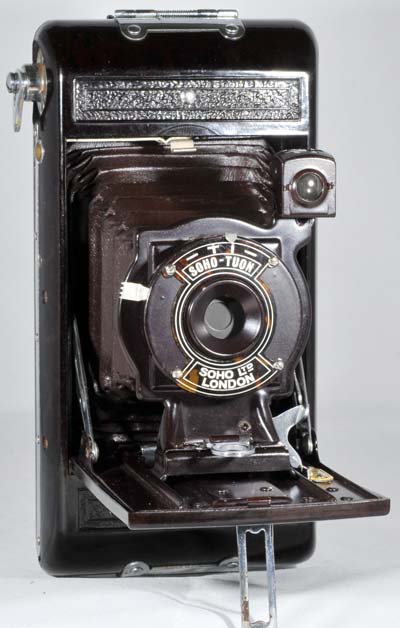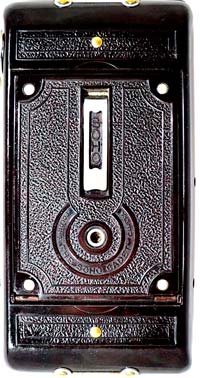Soho Tuon
Specification

| Manufacturer | : | Soho Ltd |
|---|---|---|
| Produced | : | 1933 |
| Classification | : | Medium Format |
| Body Type | : | Folding Bed |
| Bellows Deployment | : | Sliding Rail |
| Construction | : | Dark Brown/Maroon Bakelite |
| Film Type | : | 120 |
| Film Width | : | 62mm |
| Image Size | : | 2¼ x 1⅝ |
| No. of Images | : | 16 |
| Lens Type | : | Meniscus |
| Focal Length | : | 70mm |
| Focus Type | : | Fixed |
| Focal Range | : | 6ft - inf. |
| Aperture Type | : | Fixed |
| Apertures | : | f/10 |
| Shutter Type | : | Single Leaf |
| Shutter Speeds | : | T, I*(1/50s) |
| Size Open (w x h x d) | : | 95 x 175 x 130 mm |
| Size Closed (w x h x d) | : | 95 x 175 x 37 mm |
| Weight | : | 564g |
| * Measured on this camera | ||
Art Deco Credentials
![]()
![]()
![]()
Noteworthy: Worth giving special attention
- Produced during the main Art Deco period.
- Decorative dark brown/maroon Bakelite.
- Curvilinear moulding on base plate.
- Decorative mouldings to Bakelite body with leather-look finish.
- Chrome used on decorative struts.
- Chrome winder.
- Chrome strips on body sides.
- Decorative latch.
- Chrome bezels to red windows.
- Matching brown/maroon bellows.

Description

The Soho Tuon is a 120 roll film camera sold by Soho Ltd. in London, c.1933. Construction is of very dark red/maroon Bakelite. The body is complemented with brown leather bellows. The Bakelite body is embossed with a leather type pattern with geometric lines, boxes and circles. It has a generous amount of chrome fittings and design highlights. The camera has a chrome table stand. It is a strut folder but is not self-erecting. It is erected by pulling on a tab and setting the lens in one of two positions - 'NEAR' or 'FAR'. 'FAR' is for normal operation with depth of field to infinity, 'NEAR is for close-ups. It has a brilliant view-finder that swivels for portrait or landscape.
Film advance is indicated by two red windows and is not coupled to shutter. The two red windows are used to get 16 exposures from 120 film. The film is advanced until a number appears in the first window and an image is taken. Then the film is advanced until the same number appears in the second window. Then it's back to the first window for the next number.
The Tuon takes 16 6×4cm pictures on 120 film. It has a fixed-focus meniscus lens in an everset shutter with 'I' for Instant and 'T' for timed. In instant mode, the shutter is tripped alternately up/down for each frame. In timed mode the shutter fires with the shutter lever tripped in either direction. The measured shutter speed on this camera is 1/50 seconds
The camera has a tripod mount and a table stand on the base board.
Observations
I don't think the design of this camera was thought through. It uses the body moulding of the Soho Cadet which took eight 6 x 9 images. It has been modified to produce sixteen 6 x 4 cm images. This produced a camera which was cheap but was too large for the smaller images it exposed. Although technically sound, I suspect a photographer would prefer a camera having the same specifications but being much smaller and easier to handle.
How to Use
This camera takes 120 film which is widely available.
The aperture is set at about f/10. The measured speed on this camera was 1/50s. As the shutter speed is only 1/50s, it is advisable to use a tripod to get clear shake free images. However, holding it against a wall or other solid object would work as well. For quick snapshots, hold it firmly against your body.
The table shows how this camera will perform using ISO 100/125 film. It is based on the 'Sunny 16' rule. Modern film is so forgiving and will produce acceptable results even when overexposed by 2 or 3 stops or underexposed by 1 stop.
The tables assume that the sun is at least 30 degrees above the horizon - that's 10am - 5pm on a summers day in the UK.
Remember that the exposure guide in the manual may not be helpful as it is based on the use of old film with a low ISO value.
Using ISO 100/125 film - shutter speed 1/50s
| Weather Conditions | Shadow Detail | Aperture | Exposure |
|---|---|---|---|
 Sunny SunnySnow/Sand | Dark with sharp edges | f/10 | +3 Stops Overexposed Acceptable |
 Sunny Sunny | Distinct | f/10 | +2 Stops Overexposed Acceptable |
 Slight Overcast Slight Overcast | Soft around edges | f/10 | +1 Stop Overexposed Acceptable |
 Overcast Overcast | Barely visible | f/10 | Good |
 Heavy Overcast Heavy Overcast | None | f/10 | -1 Stop Underexposed Acceptable |
 Open Shade Open Shade/Sunset | None | f/10 | -2 Stops Underexposed Not Acceptable |